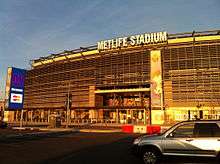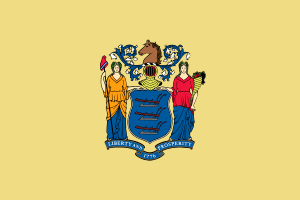Polo Grounds
| "The Bathtub" | |
|
The Polo Grounds during the 1913 World Series between the New York Giants and the Philadelphia Athletics | |
| Former names | Brotherhood Park (1890), Brush Stadium (1911–1919) |
|---|---|
| Location | bounded by West 155th Street, Frederick Douglas Blvd. and Harlem River Drive in Washington Heights, Upper Manhattan |
| Coordinates | 40°49′51″N 73°56′15″W / 40.83083°N 73.93750°WCoordinates: 40°49′51″N 73°56′15″W / 40.83083°N 73.93750°W |
| Owner | New York Giants |
| Operator | New York Giants |
| Capacity |
34,000 (1911) 55,000 (1923) |
| Field size |
Left Field: 279 ft (85 m) Left-Center: 450 ft (137 m) Center Field: 483 ft (147 m) Right-Center: 449 ft (136 m) Right Field: 258 ft (78 m) |
| Surface | Grass |
| Construction | |
| Broke ground | 1890 |
| Opened | April 19, 1890 |
| Renovated | June 28, 1911 |
| Expanded | 1923 |
| Closed | December 1963 |
| Demolished | April 10, 1964 |
| Architect | Henry B. Herts |
| Tenants | |
|
New York Giants (PL) (1890) New York Giants (NL) (1891–1957) New York Yankees (AL) (1913–1922) New York Mets (NL) (1962–1963) New York Brickley Giants (NFL) (1921) New York Giants (NFL) (1925–1955) New York Titans/Jets (AFL) (1960–1963) New York Bulldogs (NFL) (1949) Gotham Bowl (NCAA) (1961) | |
The Polo Grounds was the name of three stadiums in Upper Manhattan, New York City, used mainly for professional baseball and American football from 1880 until 1963. The third Polo Grounds, built in 1890 and renovated after a fire in 1911, is the one generally indicated when the Polo Grounds is referenced. It was located in Coogan's Hollow and was noted for its distinctive bathtub shape, very short distances to the left and right field walls, and an unusually deep center field. As the name suggests, the original Polo Grounds, opened in 1876 and demolished in 1889, was built for the sport of polo. Bounded on the south and north by 110th and 112th Streets and on the east and west by Fifth and Sixth (Lenox) Avenues, just north of Central Park, it was converted to a baseball stadium when leased by the New York Metropolitans in 1880.
In baseball, the original Polo Grounds was home to the New York Metropolitans from 1880 until 1885, and the New York Giants from 1883 until 1888. The Giants played in the second Polo Grounds for part of the 1889 season and all of the 1890 season, and at the third and fourth Polo Grounds from 1891 through 1957. The Polo Grounds was also the home field of the New York Yankees from 1913 until 1922 and the New York Mets in their first two seasons of 1962 and 1963. It hosted the 1934 and 1942 Major League Baseball All-Star Games.
In football, the third Polo Grounds was home to the New York Brickley Giants for one game in 1921 and the New York Giants from 1925 to 1955. The New York Jets of the American Football League played at the stadium from the league's inaugural season of 1960 through 1963.
Other sporting events held at the Polo Grounds included soccer, boxing, and Gaelic football. The last sporting event at the Polo Grounds was a football game between the New York Jets and the Buffalo Bills on December 14, 1963. Shea Stadium opened in 1964 and replaced the Polo Grounds as the home of the Mets and Jets. The Polo Grounds was demolished over a period of four months that year and a public housing complex, known as the Polo Grounds Towers, was built on the site.
Polo Grounds I
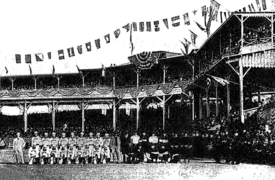
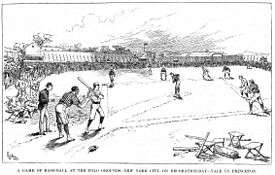
The original Polo Grounds stood at 110th Street between Fifth Avenue and Sixth Avenue, directly across 110th Street from the northeast corner of Central Park. The venue's original purpose was for the sport of polo, and its name was initially merely descriptive, not a formal name, often rendered as "the polo grounds" in newspapers. The Metropolitans, an independent team of roughly major-league caliber, was the first professional baseball team to play there, beginning in September 1880, and remained the sole professional occupant through the 1882 season. At that time the Metropolitans' ownership had the opportunity to bring it into the National League, but elected instead to organize a new team, the New York Gothams—who soon came to be known as the Giants—mainly using players from the Metropolitans and the newly defunct Troy Trojans, and entered it in the National League, while bringing what remained of the Metropolitan club into the competing American Association. For this purpose the ownership built a second diamond and grandstand at the park, dividing it into eastern and western fields for use by the Giants and Metropolitans respectively. Polo Grounds I thus hosted its first Major League Baseball games in 1883 as the home stadium of two teams, the American Association Metropolitans and the National League Gothams.[1] The dual-fields arrangement proved unworkable because of faulty surfacing of the western field, and after various other arrangements were tried, the Metropolitans and Giants alternated play on the eastern field in later years until the Metropolitans moved to the St. George Cricket Grounds on Staten Island in 1886.
An early highlight of Giants' play at the Polo Grounds was Roger Connor's home run over the right-field wall and into 112th Street; Connor eventually held the record for career home runs that Babe Ruth would break in 1920.
The original Polo Grounds was used not only for Polo and professional baseball, but often for college baseball and football as well—even by teams outside New York. The earliest known surviving image of the field is an engraving of a baseball game between Yale University and Princeton University on Decoration Day, May 30, 1882.[2] Yale and Harvard also played their traditional Thanksgiving Day game there on November 29, 1883 and November 24, 1887.[3] (See Football below)
Demolition and forced relocation
New York City was in the process of extending its street grid into uptown Manhattan in 1889. Plans for an extended West 111th Street ran through the grounds of the Polo Grounds. City workers are said to have shown up suddenly one day and begun cutting through the fence to lay out the new street. With the Giants having won the National League pennant the year before there was significant sentiment in the city against the move; a bill was even passed by the state legislature giving the Giants a variance which would allow the park to stand. Governor David B. Hill, who had campaigned for office on a "home rule" pledge, vetoed it on the grounds that whatever he might think of the forced destruction of the park, the will of the city government was to be respected. The loss of their park forced the Giants to look quickly for alternative grounds.
The Giants opened the 1889 season at Oakland Park in Jersey City, New Jersey, playing their first two games there.[4][5] Four days later, they moved to the St. George Cricket Grounds (where the Metropolitans had continued to play until their demise in 1887).[6]
After closing out a homestand at the St. George Grounds on June 14, the Giants went on the road. Upon their return on July 8 they had relocated again, to another site within Manhattan at the far terminus of the then Ninth Avenue Elevated at 155th Street and 8th Avenue (now Frederick Douglass Boulevard).[7] Despite their vagabond existence in 1889, the Giants managed to win the pennant for the second consecutive year.
Polo Grounds II
The new site was overlooked to the north and west by a steep promontory known as Coogan's Bluff. Because of its elevation, fans frequently watched games from the Bluff without buying tickets.[8] The ballpark itself was in bottomland known as Coogan's Hollow. The grandstand had a conventional curve around the infield, but because of the shape of the property left the center field area actually closer than left center or right center. This was not much of an issue in the "dead ball era" of baseball. The land remained in the Coogan estate, and the Giants were renters for their entire time at the ballpark. The Brooklyn Dodgers played a pair of home series at this ballpark in late July and early August 1890.[9]

After the National League version of the New York Giants moved into Polo Grounds III in 1891, Polo Grounds II was referred to as Manhattan Field, and was converted for other sports such as football and track-and-field. It still existed as a structure for nearly 20 more years. Babe Ruth's first home run as a Yankee, on May 1, 1920, was characterized by the New York Times reporter as a "sockdolager" (i.e. a decisive blow), and was described as traveling "over the right field grand stand into Manhattan Field."[10] Bill Jenkinson's modern research indicates the ball traveled about 500 feet in total, after clearing the Polo Grounds double decked right field stand. Manhattan Field was a playground or vacant lot by then. Some years later, the area was paved over, to serve as a parking lot for the Polo Grounds.
Polo Grounds III and IV
Polo Grounds III
Polo Grounds III was the stadium that made the name famous. Built in 1890, it initially had a completely open outfield bounded by just the outer fence, but bleachers were gradually added. By the early 1900s, some bleacher sections encroached on the field from the foul lines about halfway along left and right field. Additionally, there was a pair of "cigar box" bleachers on either side of the "batter's eye" in center field. The expansive outfield was cut down somewhat by a rope fence behind which carriages (and early automobiles) were allowed to park. By 1910, bleachers enclosed the outfield, and the carriage ropes were gone. The hodge-podge approach to the bleacher construction formed a multi-faceted outfield area. There were a couple of gaps between some of the sections, and that would prove significant in 1911.
Known as "Brotherhood Park" when it opened in 1890, Polo Grounds III was the home of a second New York Giants franchise in the Players' League. The latter was a creation of Major League Baseball's first union, the Brotherhood of Professional Base-Ball Players. After failing to win concessions from National League owners, the Brotherhood founded its own league in 1890. The Players' League Giants played in a new stadium called Brotherhood Park, located in the northern half of Coogan's Hollow, next door to the old Polo Grounds II, otherwise bounded by rail yards and the bluff. Brotherhood Park hosted its first game on April 19, 1890.[11] For one year the two editions of the Giants were neighbors, with the National League Giants still playing in Polo Grounds II. If the teams played on the same day, fans in the upper decks could watch each other's games, and home run balls hit in one park might land on the other team's playing field. After only one season the Players' League folded, and the Brotherhood's members went back to the National League. The National League Giants then moved out of Polo Grounds II and into Brotherhood Park, which was bigger. They took their stadium's name with them, turning Brotherhood Park into the Polo Grounds. They stayed there for 69 seasons.[12]

Fire and reconstruction as Polo Grounds IV

On Friday, April 14, 1911, a fire of unknown origin swept through the stadium's horseshoe-shaped grandstand, consuming wood and leaving only steel uprights in place. The gaps between some sections of the stands saved a good portion of the outfield seating and the clubhouse from destruction. Giants owner John T. Brush decided to rebuild the Polo Grounds with concrete and steel, renting Hilltop Park from the Yankees during reconstruction.
Progress was sufficient to allow the stadium to reopen just three months later, June 28, 1911, the date some baseball guides date the structure. As configured, it was the ninth concrete-and-steel stadium in the Majors and fourth in the National League. Unfinished seating areas were rebuilt during the season while the games went on. The new structure stretched in roughly the same semicircle from the left field corner around home plate to the right field corner as prior but was extended into deep right-center field. The surviving wooden bleachers were retained basically as is, with gaps remaining on each side between the new fireproof construction.

The Giants rose from the ashes along with their ballpark, winning the National League pennant in 1911 (as they also would in 1912 and 1913). As evidenced from the World Series programs, the team renamed the new structure Brush Stadium in honor of their then-owner John T. Brush, but the name did not stick, and it died with him. The remaining old bleachers were demolished during the 1923 season when the permanent double-deck was extended around most of the rest of the field and new bleachers and clubhouse were constructed across center field. This construction gave the stadium its familiar bathtub style shape, as well as a new nickname, "The Bathtub".
This version of the ballpark had its share of quirks. The "unofficial" distances (never marked on the wall) down the left and right field lines were 279 and 258 feet respectively, but there was a 21-foot overhang in left field, which often intercepted fly balls which would otherwise have been catchable and turned them into home runs. Contrasting with the short distances down the lines were the 450 distances in deepest left and right center (the gaps), with the base of the straightaway centerfield clubhouse standing 483 feet distant from home plate, up a 58-foot fairway from the grandstand corners on either side of the clubhouse, which were themselves 425 feet from home plate. The famous photo of The catch made by Willie Mays in the 1954 World Series against Vic Wertz of the Cleveland Indians occurred immediately in front of the "batter's eye", a metal screen atop the grandstand wall directly to the right of the centerfield fairway. Consequently, the ball travelled less than 425 feet (probably about 410–415 feet), admittedly a prodigious smash, but far less than the legendary length many assume. It would have been a home run in several other ballparks of the time as well as in most of today's modern ballparks. The bullpens were actually in play, in the left and right center field gaps.[13] The outfield sloped downward from the infield, and people in the dugouts often could only see the top half of the outfielders.
The New York Yankees sublet the Polo Grounds from the Giants during 1913–1922 after their lease on Hilltop Park expired. After the 1922 season, the Yankees built Yankee Stadium directly across the Harlem River from the Polo Grounds, which spurred the Giants to expand their park to reach a comparable seating capacity to stay competitive. However, since nearly all the new seating was in the outfield, Yankee Stadium still had more desirable seats than did the Polo Grounds for watching baseball. However, the Polo Grounds became better suited for football due to the new seating placement.
The Giants' first night game at the stadium was played on May 24, 1940.
Death at the Polo Grounds
On July 4, 1950, Bernard Doyle, a 56-year-old New Yorker originally from Dublin, was accidentally shot and killed while in his seat at the Polo Grounds. Doyle had brought a friend's 13-year-old son with him to see the Brooklyn Dodgers play the Giants. He was killed by a stray bullet about an hour prior to the start of the game.[14] A 14-year-old boy later confessed to having shot a gun into the air from his rooftop at 515 Edgecombe Avenue, out of frustration with his view of the ballpark being obstructed by a parapet. On August 17, 1920, Indians shortstop Ray Chapman was hit in the head by a pitch thrown by the Yankees' Carl Mays. There were no batting helmets back then. Chapman died 12 hours after he was hit, at 4:30 a.m. He remains the only baseball player to die from a head injury in MLB.[15]
Giants' final years
The Polo Grounds' end was somewhat anticlimactic, especially compared to other "Jewel Box" parks. Part of the problem was that the stadium was not well maintained from the late 1940s onward; while the baseball Giants owned the stadium, they did not own the parcel on which it stood. Moreover, the neighborhood around the stadium had deteriorated by the early 1950s. All of this combined to severely suppress ticket sales, even when the Giants played well. In 1954, for example, the baseball Giants only drew 1.1 million fans (compared to over two million for the Milwaukee Braves) even as they won the World Series.
The football Giants left for Yankee Stadium across the Harlem River following the 1955 NFL season, and the baseball Giants' disastrous 1956 season (most of which they spent in last place before a late-season surge moved them up to sixth) caused a further drag on ticket sales. The Giants' 1956 attendance was less than half of the figure for the Giants' World Series-winning 1954 season. This hit Giants owner Horace Stoneham particularly hard. He was not nearly as wealthy as his fellow owners; the Giants were his sole source of income. As such, the departure of the football Giants and the baseball Giants' increasingly meager ticket sales left him with little to no money for stadium upkeep.
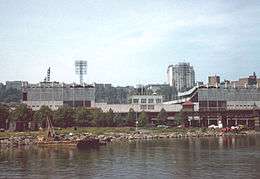
Frustrated with the obsolescence and increasing dilapidation of the Polo Grounds, Stoneham seriously considered having the Giants become tenants of the Yankees in the Bronx. He also considered moving to a proposed stadium that would have been owned by the city.[16] However, when both of those plans fizzled, the Giants announced on August 19, 1957, that they would move following that season, after nearly three-quarters of a century, to San Francisco, California, following the Dodgers to the West Coast. The Giants had won five World Series in the Polo Grounds.
The final years of the Polo Grounds
The ballpark then sat largely vacant for nearly three years, until the newly formed Titans of New York (present-day New York Jets) began play in 1960, followed by the newly formed Mets in 1962, using the Polo Grounds as an interim home while Shea Stadium was being built. As a 1962 baseball magazine noted, "The Mets will have to play in the Polo Grounds, hardly the last word in 20th Century stadia."
In 1961, the city of New York decided to claim the land under eminent domain, for the purpose of condemning the stadium and building a high-rise housing project on the site. The Coogan family, which still owned the property, fought this effort until it was finally settled in the city's favor in 1967.[17]
In the 1992 book The Gospel According to Casey, by Ira Berkow and Jim Kaplan, it is reported (p. 62) that in 1963, Mets manager Casey Stengel, who had bittersweet memories of his playing days at the Polo Grounds, had this to say during a rough outing to pitcher Tracy Stallard, whose greatest claim to fame had been giving up Roger Maris' 61st homer in 1961: "At the end of this season, they're gonna tear this joint down. The way you're pitchin', the right field section will be gone already!"
Demolition
The final iteration of the Polo Grounds was demolished in 1964, beginning in April with the same wrecking ball (painted to look like a baseball) that had been used four years earlier on Ebbets Field. The wrecking crew wore Giants jerseys and tipped their hard hats to the historic stadium as they began dismantlement. It took a crew of 60 workers more than four months to level the structure. The site is now home to the Polo Grounds Towers, a public housing project opened in 1968 and managed by the New York City Housing Authority.
Sports other than baseball
Football
The various incarnations of the Polo Grounds were well-suited for football, and hundreds of football games were played there over the years.
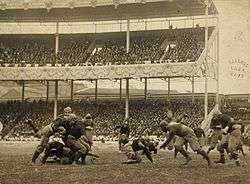
Yale University played football in the original 110th Street Polo Grounds in the 19th century, for some games which were expected to draw large crowds, including the Thanksgiving contests in 1883 and 1887.[3] (See also List of Harvard-Yale football games).
The first professional football game played in New York City was played at the Polo Grounds on December 4, 1920. The game featured the Buffalo All-Americans against the Canton Bulldogs in the first year of the American Professional Football Association. The Buffalo All-Americans won the game, 7-3. Some argue that the Buffalo All-Americans are tied with the Akron Pros for the first championship of the American Professional Football Association, which soon came to be known as the National Football League. In 1921 the NFL's New York Brickley Giants played the final game of their 1921 season against the Cleveland Indians at the Polo Grounds. The game ended in a 17–0 Giants loss.[18] Shortly afterwards, the team folded. The Brickley Giants were originally formed with the intent of competing in 1919, and having all of their home games held at the Polo Grounds. However, after the team's first practice, the 1919 schedule, that began with an opening day game against the Massillon Tigers, was scratched because of conflict with New York's blue laws. In 1919, the city allowed professional baseball on Sunday and the Giants thought the law would also apply to football. However, it was ruled that professional football was still outlawed on Sundays, so the team disbanded until 1921.
Other than the name, there is no relation between the Brickley Giants and the modern New York Giants franchise.[19]
Both the New York Giants of the National Football League and the New York Jets (then known as the New York Titans) of the American Football League used the Polo Grounds as their home field before moving on to other sites. The Giants moved initially to Yankee Stadium in 1956 while the Jets, founded in 1960, followed the New York Mets to Shea Stadium in 1964.
The grounds were also used for many games by New York-area college football teams such as Fordham and Army. An upset victory by the visiting University of Notre Dame over Army in 1924 led to Grantland Rice's famous article about the Irish backfield, which he called "The Four Horsemen". The field was also the site of several Army–Navy Games in the 1910s and 1920s.
The football Giants hosted the 1934, 1938, 1944, and 1946 NFL championship games at the Polo Grounds. In addition the Boston Redskins moved the 1936 game from Boston to the Polo Grounds, as part of their transition in relocating to Washington.
Soccer
The Polo Grounds held its fair share of international soccer matches as well over the years. In 1926, Hakoah, an all-Jewish side from Vienna, Austria, "drew the largest crowds ever to watch soccer in America up to that time: three successive games drew 25,000, 30,000, and 36,000 spectators. The highlight of the tour was a May 1, 1926 exhibition game between Hakoah and an American Soccer League all-New York team which drew 46,000 fans to the Polo Grounds in New York."[20] (The ASL team won 3–0.)
The first soccer played at the Polo Grounds was as far back as 1894 when the owners of the various major baseball clubs thought it would be a great way to fill their stadiums in the off-season. Six famous baseball franchises of the era formed Association Football sections and fans were told that many would be fielding their baseball stars on the football field in the opening season. The New York Giants soccer team took the field in all-white uniforms with black socks and played six games before the threat of a rival baseball league being formed diverted the owner's attention away from their new venture and caused it to be suspended mid-season. The Giants lay third in the league after six games with two victories, having played their matches in midweek in front of attendances in the high hundreds paying 25 cents a game. Although the owners remained positive about the venture and wanted to run it again the following season this never happened and the Giants' soccer team was no more.[21][22]
On May 19, 1935, the Scotland national team toured the United States, and in their first game played against an ASL All-Star squad which was unofficially representing the United States. Scotland won 5–1 in front of 25,000 people at the Polo Grounds. In 1939, the Scots returned to America for another tour, and played at the Polo Grounds twice. In their first game at the Polo Grounds on May 21, 1939, Scotland tied the Eastern USA All-Stars 1–1 in front of 25,072 fans. In their second game at the Polo Grounds on June 18, 1939, Scotland beat the American League Stars 4–2.
Following World War II, on September 26, 1948, the USA beat Israel 3–1 in their first ever game since independence before 25,000 fans at the Polo Grounds. On June 9, 1950, a crowd of 21,000 fans came to the Polo Grounds to watch an 'International Dream Double Header'. Beşiktaş J.K. of Turkey defeated the American Soccer League All-Stars 3–1, and then Manchester United defeated Jönköping (the top amateur team in Sweden) 4–0. On May 17, 1960, Birmingham City of England played Third Lanark of Scotland and lost 4–1 at the Polo Grounds in New York City. On August 6 of the same year, 25,440 patrons showed up at the Polo Grounds to watch the inaugural International Soccer League Final which saw Bangu of Brazil edge out Kilmarnock FC of Scotland 2–0. Bangu's six games on Polo Ground had a total attendance of 104,274. The following year, 1961, may have been the last year documented that soccer was played at the Polo Grounds. The second edition of the International Soccer League held most of its game at the Polo Grounds, with a few games held in Montreal. On July 16, 1961 Shamrock Rovers beat Red Star Belgrade 5–1, on August 9, Dukla Prague beat Everton 7–0, and four days later on August 13, Dukla Prague beat Everton again 2–0, thus winning the Dwight D. Eisenhower Trophy. The combined attendance for both games at the Polo Grounds was 31,627. In domestic league soccer, the Polo Grounds was the home to the New York Nationals of the American Soccer League in 1928.
Gaelic football
On September 14, 1947, the Polo Grounds hosted the final of the All-Ireland Senior Gaelic Football championship between Cavan and Kerry. It was decided that New York would host this match as a commemoration of the 1847 Irish famine which forced a large number of Irish people to emigrate to North America. This novel location for the game was chosen for the benefit of New York's large Irish immigrant population. It was the only time that the final has been played outside Ireland.
The last Gaelic game at the Polo Grounds was on 1 June 1958 when Cavan played New York.
Boxing
The Polo Grounds was the site of many famous boxing matches. These included the legendary 1923 heavyweight championship bout between Jack Dempsey and Luis Firpo, Harry Greb's defense of the middleweight championship title against reigning World Welterweight Champion, Mickey Walker in July 1925, and Billy Conn's near-upset over heavyweight champion Joe Louis in June 1941. It was also the venue for the rematch between World Heavyweight Champion Ingemar Johansson and former champion Floyd Patterson on June 20, 1960. In what turned out to be the last major boxing match at the Polo Grounds, Patterson became the first heavyweight boxer to regain the championship over the Swedish-born Johansson, who almost one year to the day, took the crown from Patterson at Yankee Stadium.
Motor Racing
The Polo Grounds were the site of three different oval tracks. The first track, a ¼ mile dirt oval, was used for midget racing in 1940 and 1941. The second, a 1/5 mile board track, was used briefly in 1948. The final track, a ¼ mile paved oval, was used for stock car racing in 1958 and 1959, after the Giants moved to San Francisco.[23][24]
Open-air concert

A performance of Verdi's Requiem took place at the Polo Grounds on 4 June 1916, presented by the National Open Air Festival Society. It was given by a chorus of 1,200 singers (chorus master, Arnaldo Conti), selected from among the leading choral societies of New York; and an augmented New York Philharmonic Orchestra of 120 players. The soloists were Lucile Lawrence, Maria Gay, Giovanni Zenatello and Leon Rothier, and the performance was conducted by Louis Koemmenich.[25][26][27]
Features for baseball
Center field
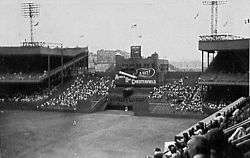

One of the oddest features at the Polo Grounds were the deep dimensions in straight away center field. The wall was so far away from home plate, at 483 feet (147 m), that few players ever hit home runs over it. Before its 1923 reconstruction, only Babe Ruth ever reached the centerfield stands; after 1923 only four players would reach the distant centerfield bleachers. The clubhouse was also located in that area, and was considered in play, as the windows were on the in-play side of the wall. The ground rules of the Polo Grounds were set up so that if a ball went through an open window in the clubhouse, it was a ground rule double, rather than a home run. Since no ball ever reached the clubhouse in the life of the stadium, that rule was never tested.
In Game 1 of the 1954 World Series, Giants outfielder Willie Mays made a sensational catch of a fly ball hit by the Cleveland Indians' Vic Wertz into deep center field, a catch which, in the words of NBC television sports announcer Jack Brickhouse, "must have looked like an optical illusion to a lot of people", and which turned the tide of that Series in the Giants' favor.
On October 2, 1936, in Game 2 of the 1936 World Series, Yankees centerfielder Joe DiMaggio made a similar, though far less crucial, catch (his team being ahead 18–4) for the final out of the game.[28][29] The Giants' Hank Leiber hit a long fly ball to deep center field that DiMaggio caught in the runway, perhaps 430–440 from the plate, and his momentum carried him partway up the clubhouse steps. He then stopped and turned around, as the crowd stood and acknowledged the departure of Franklin D. Roosevelt, who was in attendance that day.[30]
Babe Ruth hit many of his early signature blasts at the Polo Grounds, reaching the center field seats on several occasions. His longest blast at the grounds, over the right-center upper deck in 1921, was estimated at over 550 feet. Had Ruth played regularly in the remodeled Polo Grounds, he would have been capable of hitting the clubhouse if conditions were right. Neither he nor anyone else ever did, but a few came close.
After the 1923 remodeling, only four players ever hit a home run into the center field stands:[31]
- Luke Easter in a Negro League game in 1948
- Joe Adcock in 1953 (April 29)
- Hank Aaron and Lou Brock on consecutive days (June 17 and 18) in 1962.
Right field
The deep center field was complemented by the short right-field fence. Its foul pole was 258 feet (79 m) from home, one of the shortest ever used in the major leagues. Since the early 20th century, home runs that just cleared a field's shortest fence had been known as "Chinese home runs", from a stereotype of Chinese immigrant workers as doing the bare minimum required for the low wages they received for menial labor. Within baseball, by the 1940s those home runs were largely associated with the short right-field fence at the Polo Grounds. The 511 career homers hit by Giants outfielder Mel Ott, whose physique and batting technique were not those associated with power hitting, have often been downplayed because a significant number were hit to right at home, a criticism he often responded to by asking why few other hitters in the league were making that hit if it were so easy.[32]
Bobby Thomson's "Shot Heard 'Round the World" that won the 1951 National League pennant for the Giants was hit over the left field fence. But arguably the best-remembered home run hit to that side was the walk-off three-run shot by Dusty Rhodes, batting for Monte Irvin in the 10th inning of Game 1 of the 1954 Series, after Mays' catch had kept the Giants tied. It just barely cleared the fence, leading Al López, manager of the heavily-favored Indians, to attribute the Giants' stunning victory in the Series opener to the ballpark's unusual dimensions.[33]
John T. Brush Stairway

The only part of the Polo Grounds that still remains is the "John T. Brush Stairway",[34] which runs down Coogan's Bluff from Edgecombe Avenue to Harlem River Drive at about 158th Street.[35] The stairway, named for John T. Brush—the then-recently deceased owner of the Giants—opened in 1913 and led to a ticket booth overlooking the stadium. The stairway reportedly offered a clear view of the stadium for fans who did not purchase tickets to a game. A marker on the stairway reads: "The John T. Brush Stairway Presented By The New York Giants."[35]
In November 2011, it was reported that the stairway would undergo a $950,000 restoration, thanks to donations from the New York Giants, Jets, Yankees, Mets, San Francisco Giants, and Major League Baseball.[36][37] The restoration was scheduled to be completed in September 2012, but in February 2013 it was announced that a "soft opening" would take place in spring 2013.[36][38] After numerous delays, the restored steps opened finally in early August 2014.[39] The restored stairway is considered a city historic landmark.[40]
Polo Grounds light poles
The light poles from the Polo Grounds remain in use at Phoenix Municipal Stadium, a minor league facility in Phoenix, Arizona, built in 1964. When the stadium was built, Horace Stoneham, owner of the San Francisco Giants, had the original Polo Grounds light poles shipped there. The Giants held spring training at the stadium's predecessor since 1947 and played at the new ballpark during spring training 1964. The poles were installed in the stadium where they currently remain standing.[41]
Timeline and teams
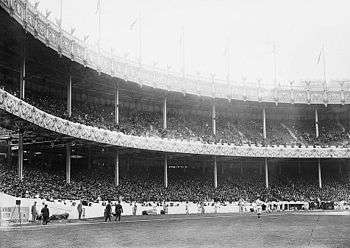
- Polo Grounds I
- Gothams/Giants (National League), 1883–1888
- Metropolitans (American Association), 1880–1885
- Polo Grounds II (otherwise known as Manhattan Field)
- Giants (NL), 1889–1890
- Polo Grounds III (originally called Brotherhood Park, also known as Brush Stadium from 1911 to 1919)
- Giants (Players' League), 1890
- Giants (NL), 1891–1911
- Giants (NL), 1911–1957
- Yankees (American League), 1913–1922
- Giants (NFL), 1925–1955
- Bulldogs (NFL) 1949
- Titans/Jets (AFL), 1960–1963
- Mets (NL), 1962–1963
Statistics
Dimensions
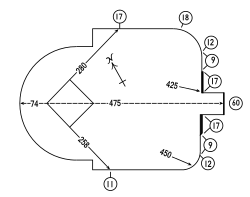
Compiled from various photos, baseball annuals, The Official Encyclopedia of Baseball (Turkin & Thompson, 1951) and Green Cathedrals by Phil Lowry.
1890–1911
- Left Field Line: 335 ft. (not posted)
- Center Field: 500 ft. (not posted)
- Right Field Line: 335 ft. (not posted)
1911–1922
- Left Field Line: 277 ft. (not posted)
- Center Field: 433 ft. (not posted)
- Right Field Line: 258 ft. (not posted)
1923–1957, 1962–1963
- Left Field Line: 279 ft. (not posted—sometimes listed as 280)
- Left Field Upper Deck Overhang: about 250 ft.
- Shallow Left Center: 315 ft.
- Left Center 1: 360 ft.
- Left Center 2: 414 ft.
- Deep Left Center: 447 ft. left of bullpen curve
- Deep Left Center: 455 ft. right of bullpen curve
- Center Field: approx. 425 ft. (unposted) corners of runways
- Center Field: 483 ft. posted on front of clubhouse balcony, sometimes 475 ft.
- Center Field: 505 ft. (unposted) sometimes given as total C.F. distance
- Deep Right Center: 455 ft. left of bullpen curve
- Deep Right Center: 449 ft. right of bullpen curve
- Right Center 2: 395 ft.
- Right Center 1: 338 ft.
- Shallow Right Center: 294 ft.
- Right Field Line: 257 ft. 3 3⁄8 in. (not posted—sometimes listed as 258)
- Backstop: 65 ft. (sometimes also given as 74 ft.)
The disparities in some of the posted distances, notably straightaway center, have not been fully reconciled by researchers. The closest object in straight center field was the Grant Memorial, followed by the post supporting the overhang of the clubhouse (above which the 483 or 475 signs were posted), and a roll-up door several feet behind the overhang at ground level. The roof of the protruding part of the clubhouse sloped back and met the vertical wall of the larger part of the clubhouse. The exact objects referred to by the numbers 475, 483, and 505 can be speculated but remain unconfirmed.
Seating capacity
1911–1916
- 34,000[42]
1917–1919
- 36,000[42]
1920–1922
- 38,000[42]
1923–1925
- 43,000[42]
1937–1939
- 51,856[42]
1947–1952
- 54,500[42]
1926–1929
- 55,000[42]
1930–1935, 1940–1946, 1953–1963
- 56,000[42]
Gallery
 Panoramic view of the Polo Grounds, October 13, 1910.
Panoramic view of the Polo Grounds, October 13, 1910.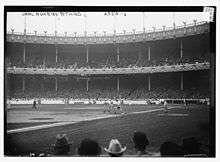 The Polo Grounds during the 1912 World Series.
The Polo Grounds during the 1912 World Series. Fans in the Polo Grounds bleachers during the 1913 World Series.
Fans in the Polo Grounds bleachers during the 1913 World Series.
 Exterior of the Polo Grounds with Harlem River Speedway in foreground, circa 1915. Note vacant lot, site of Manhattan Field.
Exterior of the Polo Grounds with Harlem River Speedway in foreground, circa 1915. Note vacant lot, site of Manhattan Field. View of the field from the grandstand.
View of the field from the grandstand. Verdi's requiem being performed at the Polo Grounds, 1916.
Verdi's requiem being performed at the Polo Grounds, 1916.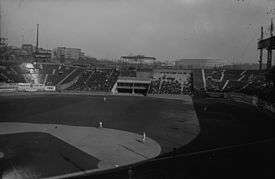 Opening Day in 1923, with the newly built Yankee Stadium visible in the distance.
Opening Day in 1923, with the newly built Yankee Stadium visible in the distance.- Polo Grounds ca. 1922
- Polo Grounds ca. 1923
See also
- Polo Grounds Shuttle, an elevated railway shuttle to the grounds
- Bushman Steps, a set of stairs descending to the grounds
References
Notes
- ↑ SABR Biography
- ↑ Harper's Young People, v. III (1882), p. 524.
- 1 2 Bergin, The Game, p. 308
- ↑ Oakland Park
- ↑ "Giants Ballparks: 1883-Present". mlb.com. Retrieved 2012-01-07.
- ↑ St. George Cricket Grounds
- ↑ 1889 game log
- ↑ http://www.hhoc.org/hist/coogans_bluff_p.htm
- ↑ 1890 Brooklyn Dodgers schedule
- ↑ http://1920yankees.blogspot.com/2006/12/may-1st-yankees-6-red-sox-0.html
- ↑ Schedule for 1890 Players' League Giants
- ↑ Polo Grounds at ballparks.com
- ↑ Aronoff, Jason (2009). Going, Going ... Caught!: Baseball's Great Outfield Catches as Described by Those Who Saw Them, 1887–1964. United States: McFarland Publishing. p. 276.
- ↑ "Mystery Bullet Kills Baseball Fan In Midst of Crowd at Polo Grounds". The New York Times. July 5, 1950. Retrieved 2011-10-30.
- ↑ Maeder, Jay; The New York Daily News (1998). Big Town Big Time. Sports Publishing LLC. p. 116. ISBN 1-58261-028-2. Cite uses deprecated parameter
|coauthors=(help) - ↑ Thornley, Stew, "The Polo Grounds (New York)", Society for American Baseball Research
- ↑ Stew Thornley, Land of the Giants, p. 116
- ↑ 1921 Brooklyn Giants season
- ↑ Pro Football Hall of Fame (1984). "Mr. Mara" (PDF). Coffin Corner. Professional Football Researchers Association. 6 (11 and 12): 1–2.
- ↑ Holroyd, Steve. "The Year in American Soccer – 1926". American Soccer History Archives.
- ↑ http://www.rsssf.com/usadave/alpf.html
- ↑ Soccer at the Polo Grounds
- ↑ Brown, Allan (2003). The History of America's Speedways:Past and Present (3rd ed.). Comstock Park, Michigan: Brown. p. 502. ISBN 0-931105-61-7.
- ↑ White, Gordon Eliot (2002). Lost Race Tracks:Treasures of Automobile Racing. Hudson, Wisconsin: Iconografix. p. 78. ISBN 1-58388-084-4.
- ↑ "New York's Greatest Open Air Musical Event" (PDF). The Theatre. New York: 364a. June 1916.
- ↑ "Open Air Presentation of Verdi's Requiem". New York Times. 21 May 1916.
- ↑ Further sources on Flickr about the event & photo (Library of Congress call number: LC-B2-3874-13).
- ↑ Diamonds Are Rough All Over, by Stanley Frank, Baseball Digest, July 1947, Vol. 6, No. 5, ISSN 0005-609X
- ↑ 1936 World Series Game 2 box score at Baseball Reference
- ↑ www.nydailynews.com
- ↑ Baseball Almanac: Polo Grounds
- ↑ Hardy Jr., James D. (2007). Baseball and the Mythic Moment: How We Remember the National Game. Jefferson, North Carolina: McFarland & Company. pp. 32–34. ISBN 9780786426508. Retrieved March 18, 2015.
- ↑ Billheimer, John (2007). Baseball and the Blame Game: Scapegoating in the Major Leagues. McFarland. pp. 94–96. ISBN 9780786429066. Retrieved March 18, 2015.
- ↑ Details about the Brush Stairway
- 1 2 Williams, Timothy (February 19, 2008). "A Stairway to Sports History From the Polo Grounds". The New York Times.
- 1 2 Mixson, Colin; Sanderson, Bill (November 7, 2011). "San Francisco Giants make $50,000 donation to restore part of Polo Grounds". Nypost.com. NYP Holdings, Inc. Retrieved 26 November 2011.
- ↑ "Restoration Of John T. Brush Stairway In High Bridge Park Finally Begun", A Walk in the Park (blog), November 8, 2011
- ↑ Post, Paul. "Stairway to heaven: Polo Grounds steps coming back". mlb.com. Retrieved 11 February 2013.
- ↑ "Harlem stairway to the Polo Grounds is back -- even if there isn't a stadium anymore". New York Daily News. August 5, 2014.
- ↑ Walsh, Kevin (November 2014). "HAMILTON and WASHINGTON HEIGHTS". Forgotten NY. Retrieved 6 November 2014.
- ↑ "Phoenix Municipal Stadium". City of Phoenix. 2016. Retrieved March 14, 2016.
- 1 2 3 4 5 6 7 8 "Polo Grounds Historical Analysis". Baseball Almanac. Retrieved 2011-11-23.
Sources
- Benson, Michael. Ballparks of North America.
- Bergin, Thomas G. The Game: The Harvard-Yale Football Rivalry. Yale Press, 1984.
- Harper's Young People. "A Game of Base-Ball at the Polo Grounds, New York City, on Decoration Day — Yale vs. Princeton.", v. III (1882), p. 524.
- Lowry, Philip J. Green Cathedrals.
- Thornley, Stew. Land of the Giants: New York's Polo Grounds.
- Ziegel, Vic (text), New York Daily News (photos), Guglberger, Claus (ed.) Summer in the City. pp. 8,71,126,184 provide good documentation of the distance-markers on the walls
External links
| Wikimedia Commons has media related to Polo Grounds. |
- The Early Polo Grounds
- Polo Grounds dynamic diagram at Clem's Baseball
- Project Ballpark, Polo Grounds I
- Project Ballpark, Polo Grounds II (covers second and third Polo Grounds)
- San Francisco Giants : History : Ballparks
- The 1947 All-Ireland final
- American Soccer History Archives
- National Soccer Hall of Fame
_(434431507).jpg)

